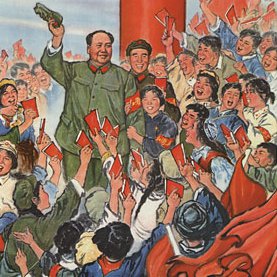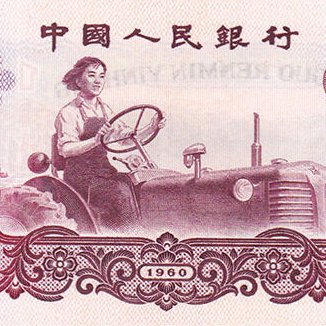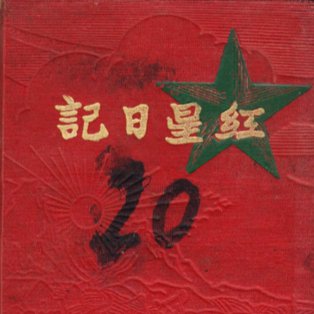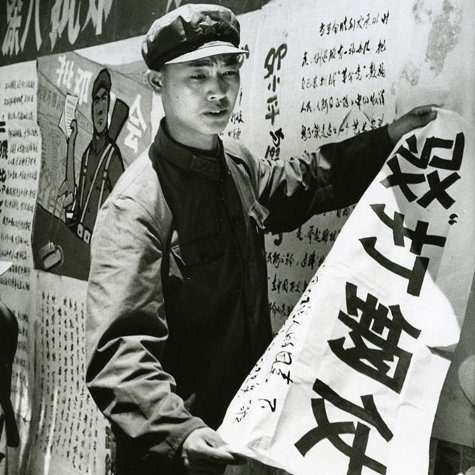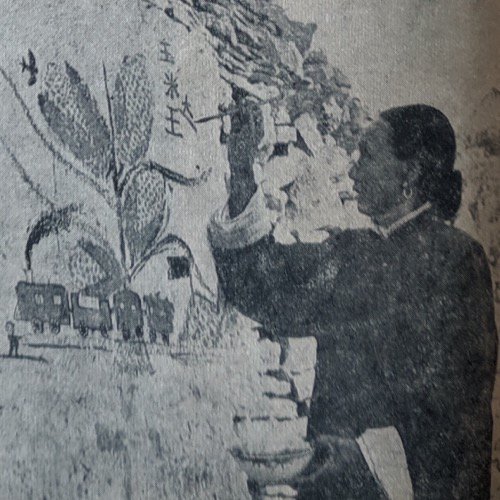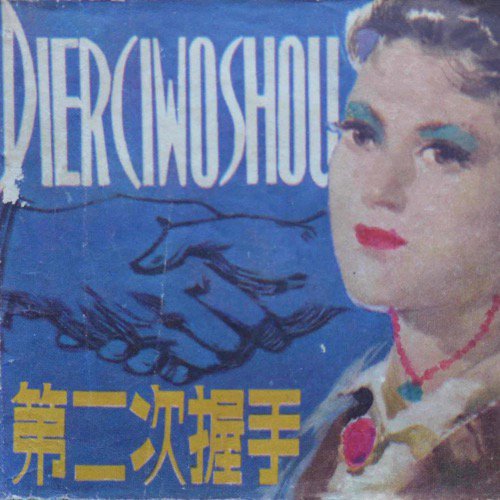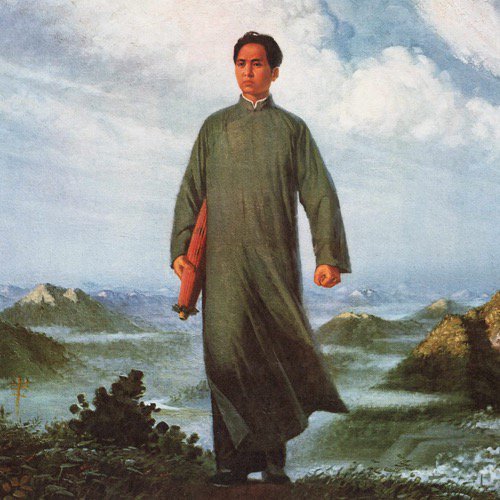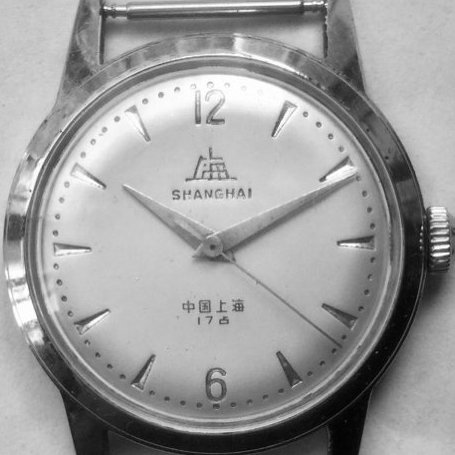Emily Williams, Xi’an Jiaotong-Liverpool University
Summary
Revolutions often produce new types of art and culture, and often the most effective forms are those that can be worn, allowing supporters to literally embody the revolution. In China, Chairman Mao badges, small pins featuring Mao’s visage, were produced as early as the revolutionary period, but they became a truly nationwide phenomenon during the Cultural Revolution, when they were worn by young Red Guards as demonstrations of their devotion to Mao. They remain present in Reform Era China, where they have entered private collections, thus entering a very different world from that which they were originally designed for.What is a Mao badge?

A Chairman Mao badge (Mao zhuxi xiangzhang 毛主席像章) is a small pin or brooch that features an image of Mao Zedong, and that normally was worn pinned to the wearer’s chest. The standard Mao badge is 1-3cm in diameter, made of aluminium, red in colour, and features a raised embossed image of Mao’s head in profile, usually facing towards the left. Beyond this basic design, however, tens of thousands of more complex designs were also made, in a variety of sizes, shapes and materials (including porcelain, plastic, bamboo and many others). Badge content was also diverse: they included references to revolutionary history, commemorated important events, and played a role in defining identities in the factional struggles during the Cultural Revolution. While exact production numbers are unknown, it is estimated that between 2 and 5 billion badges were made, mostly during the years 1966-1969. During the early years of the Cultural Revolution (1966-1969), most people owned or desired to own one or a number of badges, and many people, especially Red Guards, wore them daily. Because of this, Mao badges constitute an important part of the visual environment of the Cultural Revolution, and play a key role in many people’s recollection of the Mao era. [See ⧉source: Standard Mao badges, also depicted to the left]
Early History of Badges
The earliest badges were made in Yan’an, the main Communist base area during the Sino-Japanese War. Most early badges were handmade from materials like wood or the metal from empty toothpaste tubes [see ⧉source: Early Mao badge]. They were usually made by soldiers and students. According to Melissa Schrift, prior to 1949, there was less than 10 different designs, and they had limited production and distribution.1 The production of badges expanded after the CCP took power in 1949, and took on a primarily commemorative function. For example, Chinese soldiers returning from fighting alongside the North Korean forces in the Korean Civil War (known in China as the ‘resist America, aid Korea campaign) received star-shaped military achievement badges with Mao’s portrait on the front and a peace dove on the back. Model workers, peasants and soldiers would be awarded badges, and they were sometimes made in commemoration of the completion of public works projects.2 As such, badges were only worn by a small proportion of the population, and so brought their owners status and prestige.
Badges during the Cultural Revolution
Mao badges became a true cultural phenomenon in 1966, and many people associate Mao badges primarily with the Cultural Revolution. They were primarily made in the early years of the Cultural Revolution, between 1966 and 1969. Badges began to be produced in large numbers in factories in Shanghai and Beijing over the summer of 1966. They came to national attention in August, as many of the Red Guards that attended the first rally in Tian’anmen square wore badges, and Mao accepted a gift of Mao badges from Red Guard representatives. The movement of Red Guards around the country, particularly in the autumn of 1966, called ‘chuanlian’ (串连) or the ‘exchange of revolutionary experiences’ was crucial to the rising production and popularity of Mao badges. The high visibility of travelling Red Guards and their Mao badges raised awareness of these ‘revolutionary symbols’ in new areas, leading to more people desiring to own one. For example, one Red Guard recalled coming across a young boy in a poor area in northern China who wanted to trade the herbal medicine he had gathered for a Chairman Mao badge. The Red Guard remembered: ‘Tears welled up in my eyes. I reckoned it was the deep love of our people for Chairman Mao… I quickly took off my badge, collected several other shapes from my classmates, and gave them all to the kid. He accepted them as if they were treasures.’3
Furthermore, Red Guards often wanted ‘souvenirs’ of their travels, and would collect badges to do with the area’s revolutionary history as they travelled. Red Guard Gao Yuan 高原 got his first badge in Beijing as a souvenir to bring home, acquiring it in a badge market near Tian’anmen Square, and he continued to collect badges throughout his travels [see ⧉source: Memories of badge acquisition, Text 1 Born Red: A Chronicle of the Cultural Revolution]. Sometimes acquiring a badge from a particular place could even be a replacement for going there. For example, he reached Changsha, Hunan, but did not have sufficient money to pay the bus fare to Shaoshan, Mao’s hometown. He settled instead for a Shaoshan badge available in Changsha [see ⧉source: Shaoshan badge, for a similar image].4 Red Guards wore badges as a demonstration of their revolutionary enthusiasm and devotion to Chairman Mao. Particularly large or exquisitely designed badges, however, also brought their wearer considerable cultural capital and social credibility. Others opted for quantity of visible badges rather than quality. A story from Feng Jicai’s 冯骥才 oral historical accounts of the Cultural Revolution recalls the pride that could be attached to wearing a newly acquired badge. Feng’s narrator recalls:
'The size of these badges mattered in that the larger they were, the more loyal the wearer supposedly was – and certainly the more startlingly visible they were...All in all, these badges were the newest, largest, and most fashionable of their kind at the time. There was not the slightest doubt that they were works of great craftsmanship. Stealing glances at the “eighty-round” badge pinned to my clothes, how my classmates envied me! Especially pleased with myself, believing myself to be the most loyal to the cause, I would walk proudly with my head held high with more than a touch of exhibitionism.'5
While many wore badges as demonstration of their devotion and loyalty, others may have worn a badge just to fit in. Benewick and Donald argue that the wearer’s body was ‘landscaped’ by the badge, while Schrift suggests badges were a way for normal people to acquire the political capital necessary to survive the tumultuous events of the time.6 In other words, regardless of the wearer’s true intentions, the badge lent the wearer its symbolic strength, protecting the body through its visual imagery.
Badge production was both spontaneous and organised. Many Red Guard groups, danwei (production units) and PLA units designed, commissioned, and in some cases produced their own badges. Zhou Jihou 周继厚, a Chinese badge collector and historian of badges, estimates that at least 20,000 different organisations produced badges in the early years of the Cultural Revolution.7 New Red Guard or Red Rebel groups would commission badges to highlight their identity; factories and other production units would commission badges to commemorate important events in their organisation’s history (particularly visits by Mao or other top leaders); many PLA units wanted their own badge with their unit number stamped on the back. The formation of Revolutionary Committees at various governmental levels in the period 1967-68 was also typically marked with the production of a badge. Early badges were normally quite simple, but from the spring of 1967 onwards, the content of the badges diversified to meet these new purposes. Badges become more specifically tailored – PLA units’ badges typically include military symbolism, for example – and they become more artistic and complex. Sets of badges also began to appear, many of which depicted different important sites from the CCP’s revolutionary heritage, as well as Mao at different ages [see ⧉source: Revolutionary heritage badge]. Badge design often drew on other cultural products for inspiration: Liu Chunhua’s 刘春华 famous image ‘Chairman Mao goes to Anyuan’ was depicted on many badges [see ⧉source: Chairman Mao goes to Anyuan badge and poster]. This influence went both ways: posters frequently depicted people wearing badges too [see ⧉source: Badges in posters]. Badges were also made with text in different languages: those in English usually proclaim ‘Long Live Chairman Mao’ [see ⧉source: Revolutionary heritage badge].
While there was quite a lot of freedom in terms of commissioning and even producing badges, at the same time, however, the government tried to maintain some control. In order to try to satisfy the demand for badges, the government oversaw allocation of badge materials, especially aluminium, and provinces and cities were given production targets. There were also attempts to control production, to ensure both quality and ideological correctness, although given the fragmented state of the government this was not always easy. The government was also concerned that the badge swap markets that sprung up in many major cities would teach young people capitalist behaviours, and efforts were made to crack down on them.8
The final stage of badge production occurred in the run up to the 9th Party Congress in April 1969, an event for which millions of commemorative badges were made [see ⧉source: Mao Zedong and Lin Biao badge; ⧉source: 9th Congress Mao badge]. However, in June 1969, a Central Committee circular prohibited the production of most badges. More famously, it was around this time that Mao is said to have uttered ‘Give me back my airplanes’, a reference to the copious amount of aluminium used to made the badges.9 After 1969, a very small number of Mao badges were made, and particularly after the 1971 death of Lin Biao 林彪, a key figure in stoking the cult of Mao, badge production ground to a halt. In the early 1970s, people are often still seen wearing badges in photos and depicted as wearing badges in posters, but after 1973, this becomes less common.
Collecting badges today

After Mao’s death in 1976, the government recalled and re-cycled badges, and while it is estimated that up to 90% of badges were destroyed in this way, millions more remained in private hands.10 In the late 1980s, a new phenomenon appeared: collecting. Collecting Mao badges had began during the Cultural Revolution itself to a certain extent: Lin Biao’s wife Ye Qun 叶群, for example, formed a collection of some 10,000 badges that she planned to gift to Chairman Mao for his 73rd birthday, until it became clear that he disapproved of her practice. The existence of badge swap markets also suggests the formation of collections. But the rise of badge collecting in the late 1980s can be seen as distinct from this earlier acquisition practice because of the rise of a capitalist market, which now determined the badge’s values as commodities.11 Stamps and coins from the Mao era were the earliest collectibles to take off in the Reform Era, but in the late 1980s, media coverage of the growing financial value badges could command turned attention towards badges. The general revival of interest in Mao (known as the ‘Mao fever’ Mao re 毛热) around the centenary of Mao’s birth in 1993 also played a role, as did some people’s growing dissatisfaction with the Reform era, which provoked nostalgic recollections of the supposed purity of the Mao years [see ⧉source: Centenary Mao badge, also depicted to the right]. People collect badges for many different reasons. Some have primarily financial motivations, others like the aesthetics or want to show their continued love for Chairman Mao. Others still collect to right perceived historical wrongs. For example, well-known badge collector Zhou Jihou had a treasured badge stolen from him by some Little Red Rebels during the Cultural Revolution. In his memoirs, he recalled: ‘After I had been beaten, I made an inner vow: I would definitely collect the badges of Mao Zedong and, what is more, I would have more than anyone else. I took this wish very much to heart and, bit by bit, I began this endless process of collection.’ [See ⧉source: Memories of badge acquisition, Text 2 My Story from The Mystery of the Mao Badge]
Today, China has thousands of private badge collectors, and serious collections start at around 10,000 badges. Quality, however, is equally important as quantity, and most collectors will have some sort of speciality collection, alongside a sizeable collection of Cultural Revolution badges. This might include: badges particular to one province; model labourer or military medals from the 1950s; sets of badges; badges made from unusual materials (including leather, ivory, and various plastics[see ⧉source: Young Mao badge]) etc. Many badge collectors have private museums where their badges are on display. The largest belongs to Fan Jianchuan 樊建川, a real estate magnate and avid collector of twentieth century relics, who has a whole hall devoted to Mao badges as part of his Museum Cluster in Anren, Sichuan. The rising price of badges also produced another new phenomenon: the production of ‘fake’ (or ‘newly produced’, depending on your view) badges: many of the badges sold at tourist sites today are new, even if they look old. While telling authentic badges apart from fakes is difficult, the prevalence of serious collections ensures that Mao-era badges will be preserved for future generations.
Footnotes
Melissa Schrift, Biography of a Chairman Mao Badge: the creation and mass consumption of a personality cult (New Brunswick, NJ: Rutgers University Press, 2001), 62.
Bill Bishop, 'Badges of Chairman Mao Zedong', 1996. China News Digest International Virtual Museum of the Cultural Revolution (http://museums.cnd.org/CR/old/maobadge/).
Feng Jicai, Voices from the Whirlwind: An Oral History of the Chinese Cultural Revolution (New York: Pantheon Books, 1991), 82-87.
Yuan Gao, Born Red: A Chronicle of the Cultural Revolution (Stanford: Stanford University Press, 1987), 171.
Feng, quoted in Schrift, Biography of a Chairman Mao Badge, 113-114.
Robert Benewick and Stephanie Donald, 'Badgering the People: Mao Badges, A Retrospective 1949-1995', in Belief in China: Art and Politics; Deities and Mortality, edited by Robert Benewick (Green Centre for Non-Western Art and Culture, 1996), 37–38; Schrift, Biography of a Chairman Mao Badge, 105.
Schrift, Biography of a Chairman Mao Badge, 68-69.
The Shanghai Municipal Revolutionary Rebel Committee (上海市公安局革命造反委员会) released a series of documents in 1967 on the need to deal with the swap markets.
Bishop, 'Badges of Chairman Mao Zedong'.
Schrift, Biography of a Chairman Mao Badge, 181.
Michael R. Dutton, Streetlife China (Cambridge: Cambridge University Press, 1998), 236-7.
Sources
- ⧉ IMAGE
- 文 TEXT
- ▸ VIDEO
- ♪ AUDIO
- ⧉Image Mao Badges: Standard Mao Badges
- ⧉Image Mao Badges: Early Mao Badge
- 文Text Mao Badges: Memories Of Badge Acquisition
- ⧉Image Mao Badges: Shaoshan Badge
- ⧉Image Mao Badges: Revolutionary Heritage Badge
- ⧉Image Mao Badges: Chairman Mao Goes To Anyuan
- ⧉Image Mao Badges: Badges In Posters
- ⧉Image Mao Badges: Mao Zedong And Lin Biao Badge
- ⧉Image Mao Badges: 9th Congress
- ⧉Image Mao Badges: Centenary Mao Badge
- ⧉Image Mao Badges: Young Mao Badge
Geography
Beijing’s Tian’anmen Square and Tian’anmen rostrum are two of the most important icons in Communist China. The rostrum is frequently depicted on badges [see Mao Badges: Source Revolutionary heritage badge, 9th Congress Mao badge, Mao Zedong and Lin Biao badge].
Tiananmen Square is a large square in the centre of Beijing, named after Tiananmen, a gate to the north of the square, which separates it from the Forbidden City. It contains many important buildings in China, and has been the site of important political events. These include the May Fourth protests in 1919 and the June 4th protests in 1989.
Shaoshan was Chairman Mao’s birthplace (Mao Zedong Guju 毛泽东故居). It was a popular site for travelling Red Guards to visit during the Cultural Revolution, and it was frequently depicted on badges [See Mao Badges: Shaoshan Badge]. The Shaoshan Mao Badge Factory had one of the biggest and most diverse outputs of any badge factory during the Cultural Revolution.
Yan’an was the capital of the Shaan-Nan-Ging border region, a main Communist base area during the Sino-Japanese War. The first Mao badges were made here in the 1930s and 1940s. Later badges often make reference to Yan’an, through depictions of its characteristic pagoda on a hilltop. [See Source Mao Badges: Revolutionary heritage badge; Source Mao Badges: 9th Congress Mao badge]
Timeline
Further Reading
Bishop, Bill. 'Badges of Chairman Mao Zedong, 1996'. China News Digest International Virtual Museum of the Cultural Revolution (http://museums.cnd.org/CR/old/maobadge/).
Schrift, Melissa. Biography of a Chairman Mao Badge: the creation and mass consumption of a personality cult. New Brunswick, NJ: Rutgers University Press, 2001.
Wang, Helen. Chairman Mao Badges: Symbols and Slogans of the Cultural Revolution. British Museum Research Publication No.169. British Museum Press, 2008.
